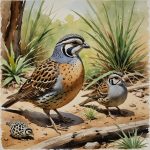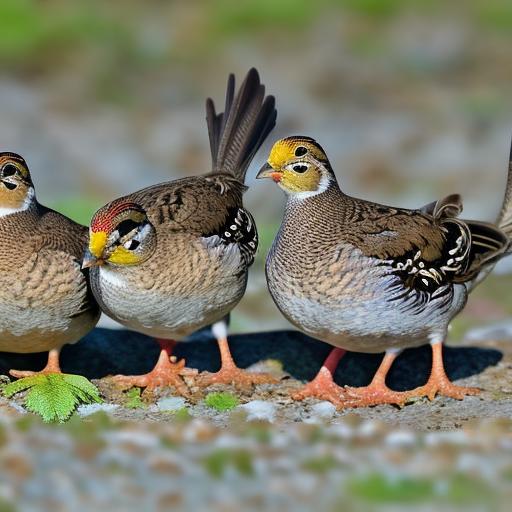In the world of feathered friends, quails are often seen scurrying about with their distinctive plumed plumes and charming chirps. But as the temperatures drop and winter settles in, many quail owners may find themselves pondering a crucial question: do these petite avians need a heat lamp to stay warm and cozy? Let’s delve into the debate and shed some light on the matter.
Table of Contents
– Understanding Quails Temperature Needs
Quails are unique birds that have specific temperature needs to thrive and stay healthy. While they are hardy creatures, providing the right environment for them is essential for their well-being. One common question that quail owners often ask is whether or not quails need a heat lamp.
Do Quails Need a heat Lamp?
Quails do not necessarily need a heat lamp, but it can be beneficial for them in certain situations. Here are some factors to consider when deciding whether to provide a heat lamp for your quails:
- Age of the quails
- Temperature of the environment
- health of the quails
When considering these factors, it is notable to monitor the temperature in the quails’ living space and adjust accordingly. A heat lamp can be a useful tool in ensuring that your quails are comfortable and healthy, especially during the colder months or for young quails.
– Benefits of Using a Heat Lamp for Quails
Using a heat lamp for quails can provide several benefits for these small birds. One of the main advantages is that it helps to regulate their body temperature, especially during colder months or when they are young. Quails are sensitive to extreme temperatures, so a heat lamp can ensure that they stay warm and comfortable.
Additionally,a heat lamp can also help to create an ideal environment for quails to thrive and grow. By providing consistent warmth, quails are less likely to experience stress and can focus on eating, drinking, and socializing. This can ultimately led to better health and productivity for the quails in your care.
– Factors to Consider Before Using a Heat lamp for Quails
Before deciding whether to use a heat lamp for your quails,there are several factors to consider. One critically important factor is the age of your quails. Young quails require more warmth than adult quails, so if you have chicks, a heat lamp may be necessary to keep them comfortable and healthy. Additionally, the environment in which your quails are kept plays a crucial role in determining the need for a heat lamp. If your quails are housed in a drafty or poorly insulated coop, a heat lamp might potentially be necessary to ensure they stay warm during colder months.
Another factor to consider is the climate in your area. If you live in a region with harsh winters or extreme temperature fluctuations,a heat lamp may be necessary to prevent your quails from getting too cold. It is indeed critically important to monitor the temperature in your quail coop regularly to ensure it remains within a safe range for your birds. Additionally, you should consider the cost and potential risks associated with using a heat lamp, such as fire hazards or increased electricity use. If you decide to use a heat lamp, make sure to follow safety precautions and use a lamp specifically designed for use with poultry.
– Alternative Heating Options for Quails
When it comes to keeping quails warm during the colder months,a heat lamp is not the only option available. There are various alternative heating options that can provide a comfortable and safe environment for your quails. One alternative is using a radiant heat panel, which mimics the warmth of the sun and provides a gentle heat source for your quails. Another option is a heated mat or pad placed at the bottom of their enclosure to keep them cozy and warm.
Additionally, you can consider using heat plates or ceramic heat emitters to provide a consistent source of heat for your quails. These options are energy-efficient and can help maintain the ideal temperature in their living space. Remember to always monitor the temperature closely to ensure that your quails are comfortable and thriving. Experiment with different heating options to find the best fit for your quail’s needs.
Q&A
Q: Do quails need a heat lamp to stay warm?
A: While quails can tolerate cooler temperatures than other poultry, a heat lamp can be beneficial in providing supplemental warmth during colder months or for young or sick birds.
Q: At what age do quails no longer require a heat lamp?
A: Quails are considered fully feathered and able to regulate their own body temperature around 6-8 weeks of age, at which point a heat lamp may no longer be necessary.
Q: What are the risks associated with using a heat lamp for quails?
A: The main risks include fire hazards from improper installation or malfunctioning equipment, as well as overheating the birds if the lamp is too close or too hot.
Q: How can I best determine if my quails need a heat lamp?
A: Monitor the behavior of your quails – if they are huddling together for warmth, showing signs of distress in cold weather, or if temperatures drop below freezing, a heat lamp might potentially be needed.
Q: Are there alternative heating options for quails besides a heat lamp?
A: Yes, some alternatives include heated pads, radiator-style heaters, or heating plates specifically designed for poultry.It’s important to choose a safe and effective option based on your setup and climate.
Insights and Conclusions
the decision to provide a heat lamp for your quails ultimately depends on various factors such as the breed of quail, the location of their habitat, and the climate conditions. It is indeed always critically important to prioritize the well-being and comfort of your feathered friends. So, whether you choose to provide a heat lamp or not, make sure to monitor their behavior and adjust their living conditions accordingly. After all, happy and healthy quails make for a delightful addition to any flock.
Meet Walter, the feathered-friend fanatic of Florida! Nestled in the sunshine state, Walter struts through life with his feathered companions, clucking his way to happiness. With a coop that’s fancier than a five-star hotel, he’s the Don Juan of the chicken world. When he’s not teaching his hens to do the cha-cha, you’ll find him in a heated debate with his prized rooster, Sir Clucks-a-Lot. Walter’s poultry passion is no yolk; he’s the sunny-side-up guy you never knew you needed in your flock of friends!




